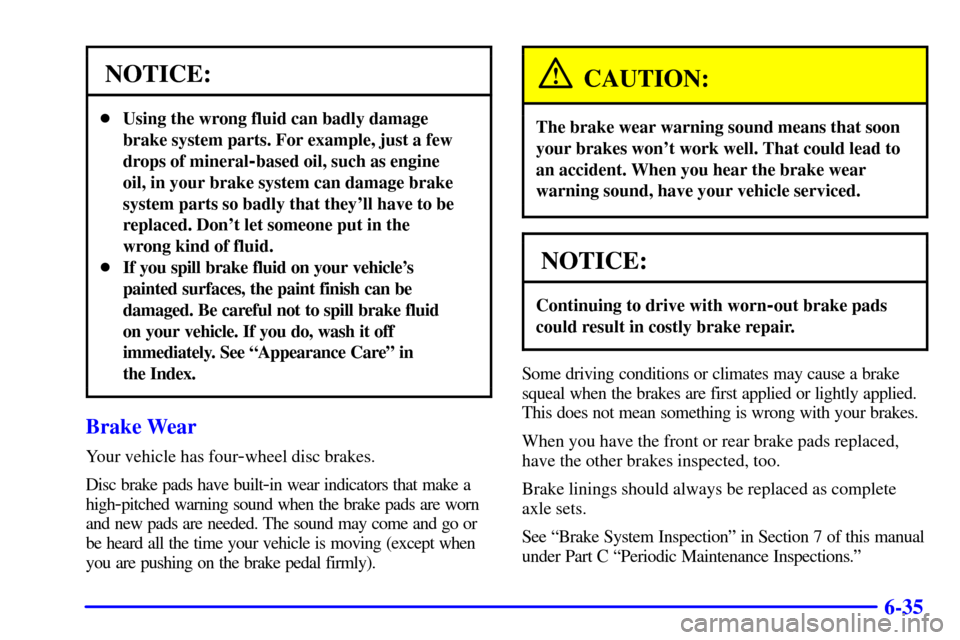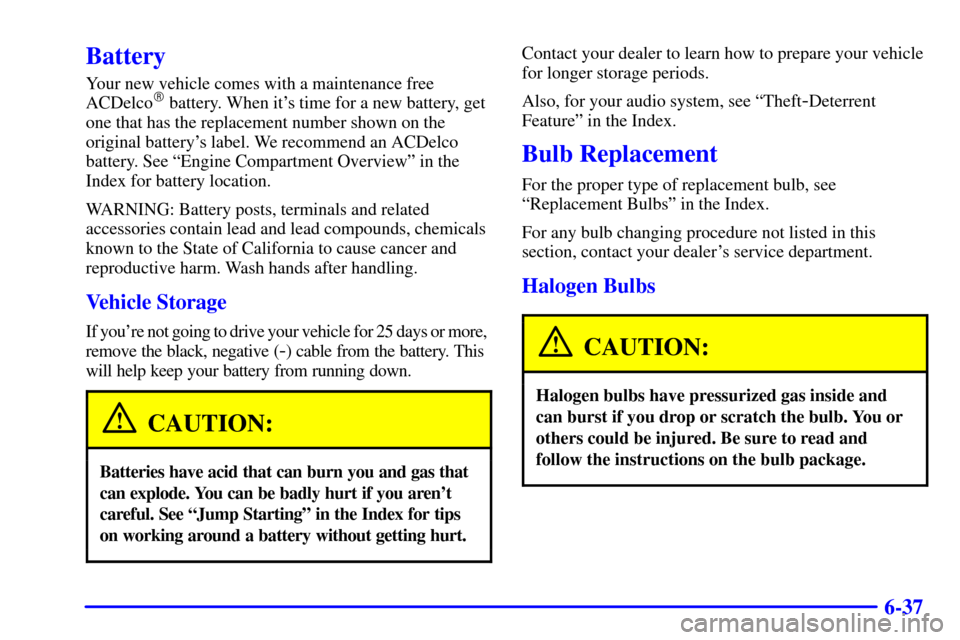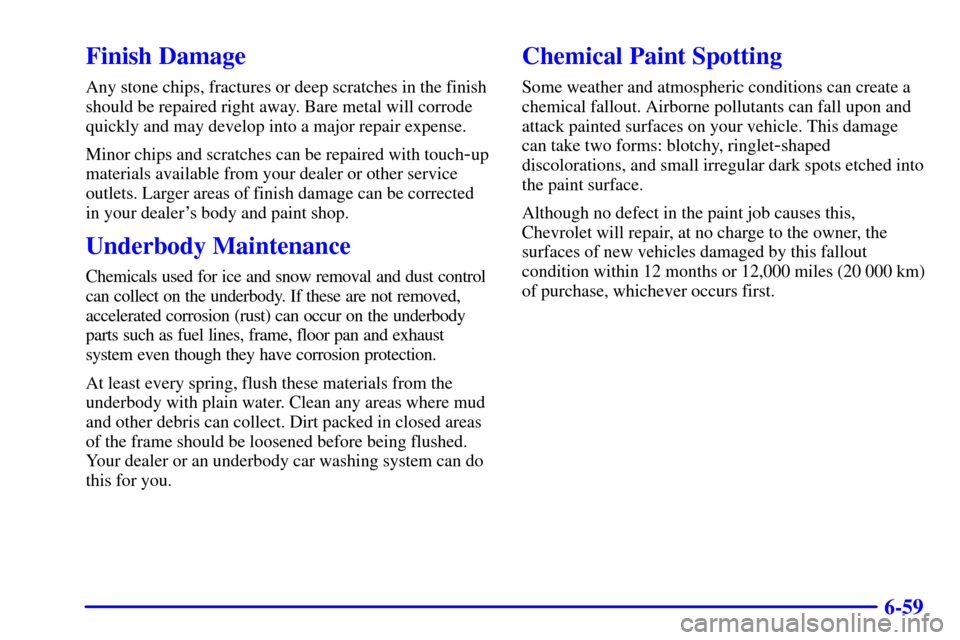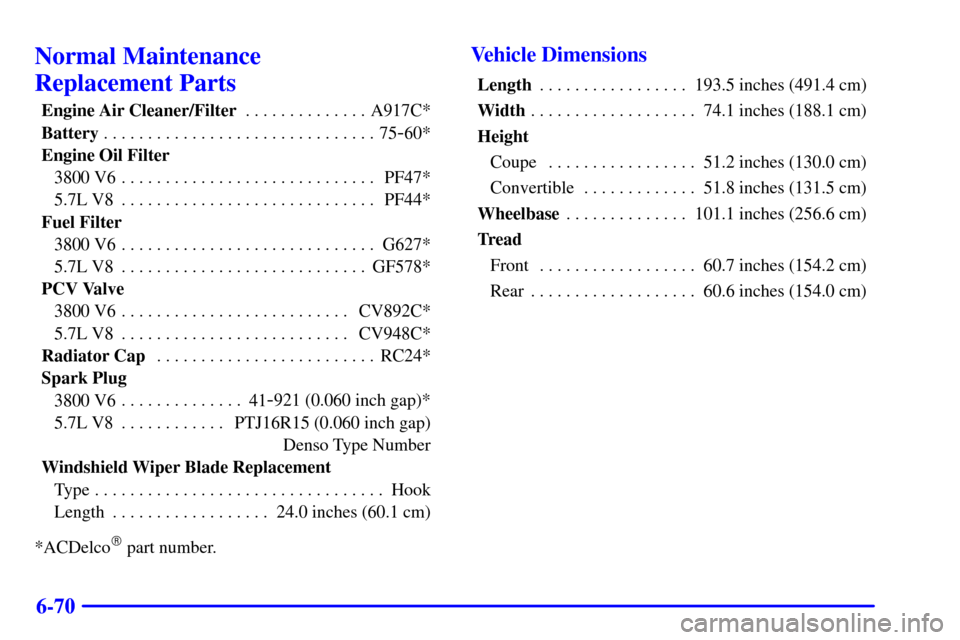Page 289 of 363

6-35
NOTICE:
�Using the wrong fluid can badly damage
brake system parts. For example, just a few
drops of mineral
-based oil, such as engine
oil, in your brake system can damage brake
system parts so badly that they'll have to be
replaced. Don't let someone put in the
wrong kind of fluid.
�If you spill brake fluid on your vehicle's
painted surfaces, the paint finish can be
damaged. Be careful not to spill brake fluid
on your vehicle. If you do, wash it off
immediately. See ªAppearance Careº in
the Index.
Brake Wear
Your vehicle has four-wheel disc brakes.
Disc brake pads have built
-in wear indicators that make a
high
-pitched warning sound when the brake pads are worn
and new pads are needed. The sound may come and go or
be heard all the time your vehicle is moving (except when
you are pushing on the brake pedal firmly).
CAUTION:
The brake wear warning sound means that soon
your brakes won't work well. That could lead to
an accident. When you hear the brake wear
warning sound, have your vehicle serviced.
NOTICE:
Continuing to drive with worn-out brake pads
could result in costly brake repair.
Some driving conditions or climates may cause a brake
squeal when the brakes are first applied or lightly applied.
This does not mean something is wrong with your brakes.
When you have the front or rear brake pads replaced,
have the other brakes inspected, too.
Brake linings should always be replaced as complete
axle sets.
See ªBrake System Inspectionº in Section 7 of this manual
under Part C ªPeriodic Maintenance Inspections.º
Page 291 of 363

6-37
Battery
Your new vehicle comes with a maintenance free
ACDelco� battery. When it's time for a new battery, get
one that has the replacement number shown on the
original battery's label. We recommend an ACDelco
battery. See ªEngine Compartment Overviewº in the
Index for battery location.
WARNING: Battery posts, terminals and related
accessories contain lead and lead compounds, chemicals
known to the State of California to cause cancer and
reproductive harm. Wash hands after handling.
Vehicle Storage
If you're not going to drive your vehicle for 25 days or more,
remove the black, negative (
-) cable from the battery. This
will help keep your battery from running down.
CAUTION:
Batteries have acid that can burn you and gas that
can explode. You can be badly hurt if you aren't
careful. See ªJump Startingº in the Index for tips
on working around a battery without getting hurt.
Contact your dealer to learn how to prepare your vehicle
for longer storage periods.
Also, for your audio system, see ªTheft
-Deterrent
Featureº in the Index.
Bulb Replacement
For the proper type of replacement bulb, see
ªReplacement Bulbsº in the Index.
For any bulb changing procedure not listed in this
section, contact your dealer's service department.
Halogen Bulbs
CAUTION:
Halogen bulbs have pressurized gas inside and
can burst if you drop or scratch the bulb. You or
others could be injured. Be sure to read and
follow the instructions on the bulb package.
Page 295 of 363
6-41
3. Turn the bulb and socket counterclockwise and
gently pull out.
4. Reverse the steps with a new bulb.
Windshield Wiper Blade Replacement
Windshield wiper blades should be inspected at least
twice a year for wear or cracking. See ªWiper Blade
Checkº in the Index for more information.
Replacement blades come in different types and are
removed in different ways. For the proper type and length, see ªNormal
Maintenance Replacement Partsº in the Index.
1. Pull the windshield wiper arm away from the windshield.
2. Push the release lever and slide the wiper assembly
toward the driver's side of the vehicle.
3. Install a new blade by reversing Steps 1 and 2.
Page 296 of 363

6-42 Wiper Blade Element Replacement
To replace the wiper blade element, follow these steps:
1. Locate the heel end of the wiper blade assembly that
has the two notches held by the wiper blade claw.
2. Hold the wiper blade assembly with one hand and
pull the element gently with the other hand.
(Replacement blade elements have three plastic caps
which retain two metal flexor strips. Do not remove
these caps before the element is installed.)3. At the heel end of the wiper blade assembly, notched
end of blade element last, slide the blade element
into the blade claw sets. The plastic retainer caps
will be forced off as the element is fully inserted.
Make sure that all the claw sets are properly engaged
in the slots of the blade element.
4. Install the wiper blade assembly on the wiper arm.
For information on wiper blade replacement length and
type, see ªNormal Maintenance Replacement Partsº in
the Index.
NOTICE:
Never open your hood with the wiper arms in the
ªService Up Positionº (wiper arms pulled away
from the windshield) because the hood will
deflect the wiper arms into the windshield and
may cause the windshield to crack.
Page 299 of 363

6-45
When to Check
Check your tires once a month or more.
Don't forget your compact spare tire. It should be
at 60 psi (420 kPa).
How to Check
Use a good quality pocket
-type gage to check tire
pressure. You can't tell if your tires are properly inflated
simply by looking at them. Radial tires may look
properly inflated even when they're underinflated.
Be sure to put the valve caps back on the valve stems.
They help prevent leaks by keeping out dirt and moisture.
Tire Inspection and Rotation
Tires should be rotated every 6,000 to 8,000 miles
(10 000 to 13 000 km). Any time you notice unusual
wear, rotate your tires as soon as possible and check
wheel alignment. Also check for damaged tires or
wheels. See ªWhen It's Time for New Tiresº and
ªWheel Replacementº later in this section for
more information.The purpose of regular rotation is to achieve more
uniform wear for all tires on the vehicle. The first
rotation is the most important. See ªScheduled
Maintenance Servicesº in the Index for scheduled
rotation intervals.
If you don't have P245/50ZR16 Goodyear Eagle GS-C
tires or P275/40ZR17 Goodyear Eagle F1
-GS tires, use
the rotation pattern shown above for your tires.
Page 313 of 363

6-59
Finish Damage
Any stone chips, fractures or deep scratches in the finish
should be repaired right away. Bare metal will corrode
quickly and may develop into a major repair expense.
Minor chips and scratches can be repaired with touch
-up
materials available from your dealer or other service
outlets. Larger areas of finish damage can be corrected
in your dealer's body and paint shop.
Underbody Maintenance
Chemicals used for ice and snow removal and dust control
can collect on the underbody. If these are not removed,
accelerated corrosion (rust) can occur on the underbody
parts such as fuel lines, frame, floor pan and exhaust
system even though they have corrosion protection.
At least every spring, flush these materials from the
underbody with plain water. Clean any areas where mud
and other debris can collect. Dirt packed in closed areas
of the frame should be loosened before being flushed.
Your dealer or an underbody car washing system can do
this for you.
Chemical Paint Spotting
Some weather and atmospheric conditions can create a
chemical fallout. Airborne pollutants can fall upon and
attack painted surfaces on your vehicle. This damage
can take two forms: blotchy, ringlet
-shaped
discolorations, and small irregular dark spots etched into
the paint surface.
Although no defect in the paint job causes this,
Chevrolet will repair, at no charge to the owner, the
surfaces of new vehicles damaged by this fallout
condition within 12 months or 12,000 miles (20 000 km)
of purchase, whichever occurs first.
Page 324 of 363

6-70
Normal Maintenance
Replacement Parts
Engine Air Cleaner/FilterA917C* . . . . . . . . . . . . . .
Battery75
-60* . . . . . . . . . . . . . . . . . . . . . . . . . . . . . . .
Engine Oil Filter
3800 V6 PF47*. . . . . . . . . . . . . . . . . . . . . . . . . . . . .
5.7L V8 PF44*. . . . . . . . . . . . . . . . . . . . . . . . . . . . .
Fuel Filter
3800 V6 G627*. . . . . . . . . . . . . . . . . . . . . . . . . . . . .
5.7L V8 GF578*. . . . . . . . . . . . . . . . . . . . . . . . . . . .
PCV Valve
3800 V6 CV892C*. . . . . . . . . . . . . . . . . . . . . . . . . .
5.7L V8 CV948C*. . . . . . . . . . . . . . . . . . . . . . . . . .
Radiator CapRC24* . . . . . . . . . . . . . . . . . . . . . . . . .
Spark Plug
3800 V6 41
-921 (0.060 inch gap)* . . . . . . . . . . . . . .
5.7L V8 PTJ16R15 (0.060 inch gap). . . . . . . . . . . .
Denso Type Number
Windshield Wiper Blade Replacement
Type Hook. . . . . . . . . . . . . . . . . . . . . . . . . . . . . . . . .
Length 24.0 inches (60.1 cm). . . . . . . . . . . . . . . . . .
*ACDelco
� part number.
Vehicle Dimensions
Length193.5 inches (491.4 cm) . . . . . . . . . . . . . . . . .
Width74.1 inches (188.1 cm) . . . . . . . . . . . . . . . . . . .
Height
Coupe 51.2 inches (130.0 cm). . . . . . . . . . . . . . . . .
Convertible 51.8 inches (131.5 cm). . . . . . . . . . . . .
Wheelbase101.1 inches (256.6 cm) . . . . . . . . . . . . . .
Tread
Front 60.7 inches (154.2 cm). . . . . . . . . . . . . . . . . .
Rear 60.6 inches (154.0 cm). . . . . . . . . . . . . . . . . . .
Page 325 of 363
7-
7-1
Section 7 Maintenance Schedule
This section covers the maintenance required for your vehicle. Your vehicle needs these services to retain its safety,
dependability and emission control performance.
7
-2 Introduction
7
-4 Part A: Scheduled Maintenance Services
7
-17 Part B: Owner Checks and Services7
-21 Part C: Periodic Maintenance Inspections
7
-23 Part D: Recommended Fluids and Lubricants
7
-25 Part E: Maintenance Record